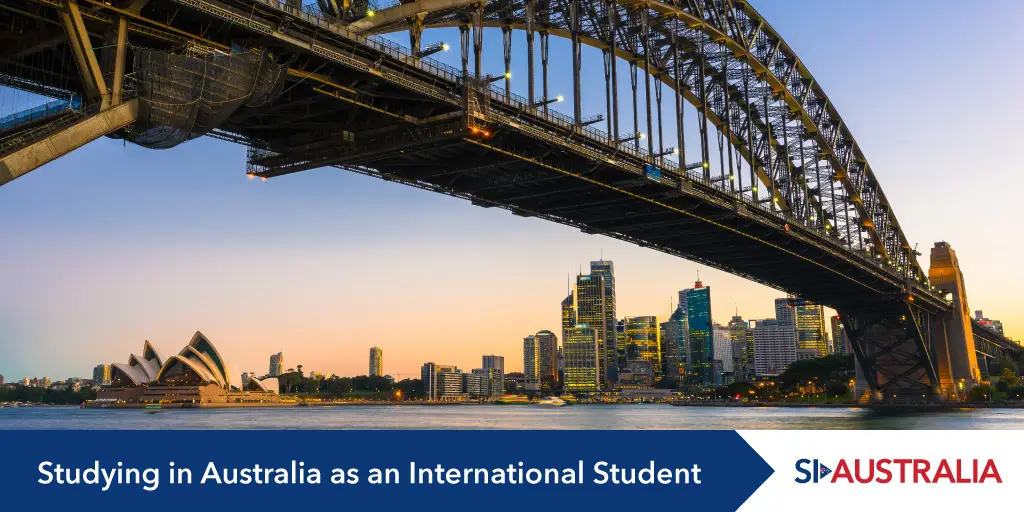When we think about Australia, we often picture beautiful coral reefs, stunning landscapes, and sandy beaches. However, there's much more to Australia, especially regarding education and learning \,and studying in Australia as an international student offers many great benefits.
If you're considering studying in Australia, it's essential to follow some key steps, from choosing your course to applying for your student visa. If you're eager to start your application to study in Australia, contact SI-Australia today.

Why Study in Australia?
1. An extensive education system
The Australian Education System provides primary, secondary, and tertiary education and is distinguished from many other countries by the Australian Qualifications Framework (AQF). The Australian Qualifications Framework is a national policy that shows how qualifications relate to each other at each level of education.
Universities in Australia offer quality education with a comprehensive curriculum and highly qualified teachers. Australia has ranked third in the world as an education destination with an excellent scope of employment.
2. Australia has six of the world’s top universities
Australia is home to some of the top universities in the world. Australian educational institutions are known for their academic excellence and research in arts and humanities, education, and sciences and these universities have nurtured 15 noble laureates.
3. Land of languages
English is spoken widely in Australia but is not the country's official language. There are over 200 dialects spoken and languages spoken by people. Australia's top five languages are Mandarin, Arabic, Cantonese, Italian, and Vietnamese.
4. Student satisfaction is high
According to a Department of Education International Student Survey, 90% of international students are delighted with their living and study experience in Australia.
5. Affordable cost of living
The cost of living and tuition fees in Australia is low compared to other countries, while living standards are some of the highest in the world. However, the cost of living depends on the city you choose to study. Besides that, Australia allows students to work part-time and support themselves financially, thus making it easier for students to thrive and survive while gaining hands-on experience.
6. Diverse culture and society
Australia is multicultural, diverse, welcoming, and inclusive for international students. They can interact with people from various backgrounds, enhancing their global perspective and cross-cultural communication skills.
7. Economic power
Australia has the world’s most extensive and highly developed economy. In terms of wealth, it stands second after Switzerland. The service sector forms the dominant section of the economy, with the most significant contribution towards GDP and employment among 80 percent of the total labour force in the country.
Step-by-Step Guide to Studying in Australia
1. Research Different Universities and Programs
Students willing to take admissions in Australia must do intense research and study about the Australian Education System, courses, and universities. Take your time, learn, and study the universities' culture and curriculum so that blending with a new culture and competitive environment can be easy.
Once you have decided what to study, it’s time to look for the best universities or institutions. Look for different factors that make a university stand out from the crowd. For example, their global reputation and ranking, employability rate, education experience, number of degrees and courses offered, and number of international students enrolled.
Shortlist around 7 to 10 universities and jot down the programs available. Study the transition period with tuition fees, scholarships, and application deadlines.
2. Speak to an SI-Australia Consultant
Ready to make the next move? Make an appointment with our SI-Australia consultant and understand the admission process from scratch. Our counselors are proficient, personally certified with years of experience, and have also been international students. They know what it is like to have the correct information before heading to a new space. So, if you have decided to study abroad, let’s work together and find out all the small and big details to ensure the best fit between you and your future university.
3. Take Standardized Tests
The next step is to appear for a standardized admission test that determines students' knowledge and skills in various subjects and areas, such as quantitative aptitude, reasoning, critical thinking, etc.
The English Language Proficiency Test should be met by aspiring students who wish to pursue Bachelor’s degrees in Australian Universities. Here are the English Proficiency Exams that are accepted in Australia -
|
English Proficiency Exam |
Average Score Required |
|
IELTS (International English Language Testing System) |
6.5 with no band below 6.0 |
|
TOEFL (Test of English as a Foreign Language) |
590 or more |
|
PTE (Pearson Test of English) |
58-64 |
|
CAE (Advanced) Cambridge Advanced English |
169 |
|
Occupational English Test (OET) |
Minimum B grade in all four sub-sets |
Academic Tests accepted for undergraduate courses:
|
Examination |
Average Score required |
|
SAT |
1200 |
|
ACT |
28 |
|
ISAT |
60 |
Academic Entrance Tests accepted for master’s courses:
|
Examination |
Average score required |
|
GMAT |
700 |
|
MCAT |
472-528 |
Some international students are sometimes exempted from providing mandatory English Proficiency Test scores if:
- They studied for at least five years in a university in Australia, New Zealand, Canada, South Africa, or the Republic of Ireland.
- Are citizens or hold a passport from the USA, UK, Canada, New Zealand, or the Republic of Ireland.
- Are pursuing their secondary or higher education in Australia.
4. Submit your application
After appearing in the various standardized tests, it’s time to register for the universities you have shortlisted. While applying for colleges and universities, read the brochure carefully. Keep all your documents handy. Your SI-Australia consultant will guide you through the rules and regulations.
5. Accept your offer
After applying to various universities in Australia, just be patient and wait for the response. The universities usually take time to review the application form and shortlist the applicants. Once a student receives an acceptance letter, read it carefully. Understand all the details included in the letter. The acceptance letter may have instructions on how to respond to the university. Follow this instructions and let the university know whether you plan to accept or decline the offer.
6. Apply for a Student Visa
Once you have accepted the offer letter, it’s time to apply for a student visa. Applying for a student visa helps you receive scholarships, affordable tuition fees, a four-year post-study work permit, and much more. The success rate for an Australian study visa is 23.3% for higher education, 18.9% for training and vocational education, and 11.8% for postgraduate research education.
There are different types of visas available. Check out the types of student visas available below to apply according to your preferences -
|
Student Visa Types |
Purpose and Validity |
|
Student Visa (subclass 500) |
|
|
Student Guardian Visa (subclass 590) |
|
|
Training Visa (subclass 407) |
|
Documents required for student visa application are as follows -
- Confirmation of enrollment (COE)
- Genuine Temporary Entrant (GTE) statement
- English Language Proficiency Test
- Proofs of Financial Capacity
- One must be at least 18 years of age.
- Obtain an Overseas Student Health Cover from an approved Australian Insurance provider.
- Character certificate stating that you have no criminal record.
Once the visa application is submitted, students will receive a Health Assessment Portal ID. They must visit the mentioned hospital designated by the Australian authority for their health checkup. Later, this medical report is directly sent to the Australian Embassy to examine the student’s profile. The entire procedure takes approximately 45 days.
7. Begin study
Once the visa application is approved, students can book their tickets. Make sure to schedule your flight before the academic session. With everything in order, students can now fasten their seat belts and look forward to embarking on their education journey and making the most out of it.
Scholarships to Study in Australia
Studying in Australia can be highly beneficial if you apply for scholarships. Australia offers more than 1,000 scholarships to international students. These scholarships provide an average monthly stipend of $20,000, tuition fees, accommodation expenses, health insurance, and travel allowances. Here are some of the popular scholarships offered by Australian Universities -
|
Scholarship Name |
Offered by |
Average stipend |
|
Australian National Scholarship |
Australian Government |
$8,000 |
|
Carnegie Mellon University Scholarship |
Carnegie Mellon University |
$20,000 |
|
Deakin Scholarships |
Deakin University |
$28,600 |
|
Charles Darwin University Scholarships |
Charles University |
50% of the tuition fee |
|
Griffith University Scholarships |
Griffith University |
50% of the tuition fee |
|
Swinburne International Excellence Scholarship |
Swinburne International Excellence Scholarship |
$2500 |
Study in Australia
If you want to begin applying to study in Australia, contact SI-Australia today for a free consultation.
Study in Australia FAQ
Can I work and study in Australia?
Yes, a student can work and study in Australia with a student visa that permits them to work and stay financially independent. If accepted to study at an Australian University, you are granted a student visa (Subclass 500).
Does the cost of studying UG and PG in Australia vary?
Yes, the cost of studying UG and PG courses varies, depending on the choice of courses, specializations, and duration of study.
What study program is best in Australia?
Australia offers a wide range of courses and programs to choose from. However, the most in-demand courses in Australia include Business, Arts, Hospitality Management, Computing, Medical and Health Sciences, and Engineering.
How much does it cost to study in Australia?
The fee structure varies for different programs. For example, the average fee for a bachelor’s course lies between $15,000 to $33,000 annually. For a master’s, it is around $20,000 to $37,000 annually.
Can I work part-time in Australia after graduation?
Students completing Australian University requirements can work part-time by applying for a post-study work permit under the graduate stream. They are allowed to work 20 hours weekly. However, students enrolled for ELICOS are not eligible for a study Work Permit for Australia.



















































































